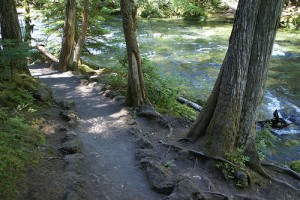Moving the majority of your training to the trails is one of the best decisions you can make. If you run on the roads every day and rarely venture into the trails, you may be missing out on one of the best injury prevention tools that’s available. And the best part is it doesn’t take any extra time.
Sure, road running has its place in a training program and you often want to stay on the roads. If you need to hit a

specific pace or distance, the roads are for you. If you are rehabbing a turned ankle you may want to avoid technical trails where you could re-injure that ankle.
But for most of us, hitting the trails most days of the week can really help your running. Trail running training increases your balance and sense of proprioception by making you run over roots, rocks, and uneven terrain. Trails often have frequent turns and elevation changes that require you to activate numerous stability muscles through your legs and core that don’t get used on a smooth road. The variation of trail running can help you avoid repetitive injuries that you might otherwise suffer if you stick to the roads.
Before moving to the woods for all of your training, you need to first prepare your body for trail running. Dancing over uneven terrain requires more agility than road running and you need to be ready for that. Besides starting on some easy trails only a few times per week, you can prepare off-trail to make a smoother transition.
Trail Training in the Gym
There are specific exercises, drills, and core work that will dramatically improve your balance and coordination. You don’t even need a gym to do the majority of these exercises. Since being out on the trails demands more agility and coordination, this trail running routine will prepare you for more technical trails.
The Trail Running Routine focuses on core strength, balance and coordination, lower leg strength, and single leg exercises to prepare you for the trails ahead. When you’re hopping over logs and making downhill turns over tree roots you’ll be thankful for the agility you gained from this routine.
- Pistol Squats – these are simply one legged squats. Start with two sets of five per leg and remember not to round your back. Go as far down as you feel comfortable and keep the motion controlled.
- Haybales – stand with feet shoulder width apart and toes pointing straight out. Hold a medicine ball at waist height and dribble it like a basketball between your legs. When you catch it, lift it up over one shoulder. Repeat and lift it over the opposite shoulder. Start with two sets of ten repetitions and increase by five weekly.
- Step-Ups – stand in front of a bench or box about knee height. Lift your left leg, plant your left foot on the box and push down firmly with your heel. Lift yourself onto the bench and then slowly lower your right leg back down to the floor. Start with 10 repetitions and build to 20 for each leg.
- Walking Lunges with weight – Holding a 5-25 lb. weight above your head with both hands, do 8-12 walking lunges forward.
- Barefoot Drills – preferably on a grass or artificial turf field (but your living room or hallway works too), perform two sets of butt-kicks, high knees, and B skips for 50-100m. Take as much rest as you need.
The most important part of doing this routine is to practice good form and keep the movement slow and controlled (with the exception of the drills, of course!).
So, Why This Routine?
You may have noticed that this strength routine focuses on three major skills that you’re going to need out there on the trails: lower leg strength, agility, and coordination. The pistol squats, walking lunges, and step-ups are single leg exercises that will increase your sense of balance and coordination. Doing any exercise on one leg instead of two will accomplish this. Feel free to alternate exercises in this routine with others that you enjoy.
Haybales and walking lunges with weight are also great exercises for your core and sense of balance. By holding a medicine ball or weight above your head, you’re forcing your body to work harder to remain upright and stable. This is hugely beneficial on a trail when you may be running over rocks or uneven surfaces.
Barefoot drills are a triple threat: they increase your running efficiency, agility, and strengthen your feet and lower legs. These are vital skills to thriving on technical terrain. Adapting your stride and taking fast steps over obstacles will help you maintain your pace and avoid tripping.
If you have been doing various strength routines that include core work, gym exercise, and form drills you may not need to prepare specifically for the trails. If that’s the case, still take the time to transition slowly to more trail running. Uneven footing and frequent elevation changes will challenge your body differently than a road or sidewalk. Take a long-term perspective and be safe about any new training stresses you introduce.
I’d love to hear about your favorite trail-specific workouts that you run! How do you prepare to run more trails? Do you do more strength work or are hills more for you? Do you just dive right in? Let me know in the comments!
If you liked this article, I’d appreciate a quick tweet to your friends or a stumble!
Photo Credit: DavidK-Oregon